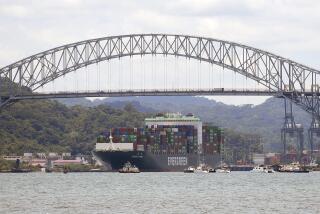A decaying symbol of progress, pride
- Share via
Zachary Karabell’s “Parting the Desert: The Creation of the Suez Canal” inevitably will be compared with David McCullough’s immensely popular “The Path Between the Seas: The Creation of the Panama Canal 1870-1914.”
Both are about the building of the two major public works that shrank the world when travel by sea was the only way to go. Both are about small groups of strong-minded men, rooted in the 19th century belief in progress, who overcame doubters and skeptics to achieve their bold visions. Both are about the forces of nationalism that, for good and bad, drove nations to assert themselves and their superiority. Both are about great engineering feats that were more important to humanity when they were constructed than they are now.
The two books, though, are written from quite different points of view. McCullough’s, exhaustive at a length of more than 700 pages, accepts at face value the greatness of the cause of which he writes and its value for humanity. “The creation of a water passage across Panama was one of the supreme human achievements of all time ...,” he wrote. “Primarily the canal is an expression of that old and noble desire to bridge the divide, to bring people together. It is a work of civilization.”
Karabell’s book, much shorter at about 320 pages, gazes at his canal through the irony-tinted spectacles of history. “Sitting at the point where the canal ends and the Red Sea begins,” he writes, “watching dilapidated freighters glide past, it is hard not to focus on decline, but that is too easy. The Suez Canal was the inscription of an idea on the face of the earth. As a vision it was beautiful and inspiring; as a reality, it has sometimes been a blessing and usually not. In its prime, it offered, at best, power and wealth. In its decay it is Ozymandias....” He refers to the poet Shelley’s image of a colossal broken statue in the desert sands inscribed “My Name is Ozymandias, king of kings: / Look on my works, ye Mighty, and despair!”
Karabell’s study excellently places the genesis of the Suez Canal in the turbulence of post-revolutionary, 19th century France, in particular in the phenomenon of Saint-Simonism. Philosopher Claude Henri de Rouvroy, comte de Saint-Simon, with his follower Auguste Comte, developed the theory that human progress could be built on the application of observable facts. The resulting “positivism” afforded carte blanche to 19th century entrepreneurship.
In this atmosphere, the French, enchanted with Egypt since Napoleon invaded it in 1798, were receptive to the visions of engineer Ferdinand de Lesseps, who imagined that a Suez Canal could at once enrich himself, his proposed shareholders and the Ottoman rulers of Egypt, and improve the fortunes of mankind by vastly shrinking the sea route to the East from Europe.
In his long effort, De Lesseps’ tenacity and personal skills brought him first the assent of the rulers of Egypt and then, crucially, the backing, through the Empress Eugenie, of Emperor Napoleon III. The British fought De Lesseps and his scheme for years. As prime minister, the frosty Lord Palmerston saw in it only a means for French aggrandizement.
Only after the ascent of Benjamin Disraeli to the prime minister’s office, the fall of Napoleon III, and the collapse of the finances of the Suez Canal’s company and those of Egypt did Britain see and seize its opportunity. The canal became the linchpin of the British Empire, and its loss to the nationalization of Egyptian chief Nasser in the 1950s the symbol of the empire’s end. As for the Egyptians, they gambled and lost. The proud independence they hoped the canal would bring never came; Europe’s imperialists proved too powerful.
Karabell deftly weaves much social and economic history of the 19th century into his lively narrative. When work on the canal began in 1859, for instance, it was with pick and shovel, done by the peasantry called Fellahin who were forced into labor by the ancient corvee system. By the time of the canal’s grand opening in 1869, much of the work had been done by giant steam shovels. In “Parting the Desert,” Karabell tells the story of a crucial development in the history of the modern world with economy and a lively grace.
More to Read
Sign up for our Book Club newsletter
Get the latest news, events and more from the Los Angeles Times Book Club, and help us get L.A. reading and talking.
You may occasionally receive promotional content from the Los Angeles Times.







